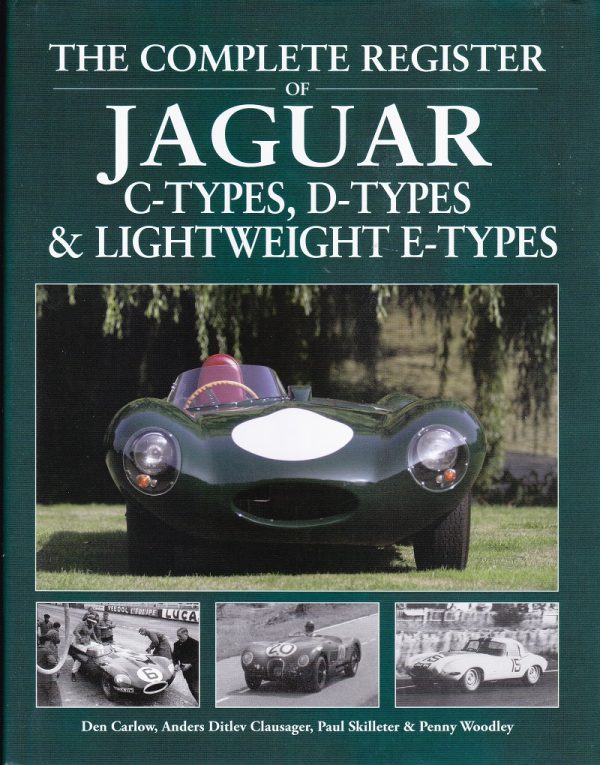
By Den Carlow, Anders Ditlev Clausager, Paul Skilleter & Penny Woodley
2023 review by James Loveridge
Even when the original Register was published in 2014 it was felt more could, and should, be written. Happily, and with the continued support of the Sommer’s Automobile Museum, the Sommer Fonden, of Denmark, who own the copyright, it has been done. The result is “The Complete Register of Jaguar C-Types, D-Types & Lightweight E-Types” by Den Carlow, Anders Ditlev Clausager, Paul Skilleter & Penny Woodley. We can be satisfied the authors know what they are talking about. Don is a long-time volunteer at the Jaguar Daimler Heritage Trust as is Penny, who is the daughter of Guy Griffiths and inherited his very significant collection of cars of this type. Anders was archivist of the British Motor Industry Heritage Trust as well as the JDHT. Paul is a publisher, author and key man in the Jaguar history world.
Clearly this “magnum opus” sets out to be the definitive history of the 55 “real” C-Types, 87 D-Types, 16 XKSS Types and 28 Lightweight or Competition E-Types. Outside the future unearthing of hitherto unknown records by deceased owners or others involved with these cars and out of proper respect for the privacy of numerous individuals, this is probably as definitive as we are likely ever to get. The word “real” is used advisedly and what Paul Griffin says about establishing the “real” history of cars in his recently published book “The Past and the Spurious” complements what is said in this excellent book. The authors explain in detail what has been done to many of these Jaguars whilst still maintaining their integrity but, in other cases, resulting in the destruction of their true identity. The many cases where genuine bits have been incorporated in more than one car are discussed. The normal practice of the Factory or team owners switching bits between contemporary cars is distinguished from cases were wrecks have been broken up with parts being incorporated in re-builds of one or more cars and genuine identities claimed for them. Several of the all too many fakes are also dealt with.
Building on the 2014 book the authors have extended their activities so that every relevant car is dealt with, although information about some is scanty. The amount of research work done, and fully referenced, including factory records, letters, published material, race reports, magazines, the internet as well as inputs from many involved with these cars over the years is truly mind boggling. There are tables covering virtually all aspects of the existence of the cars and these include lists of all cars made, by chassis number, which engines were fitted to which cars, to whom cars were first delivered as well as competition results. The stories of the attempts to improve performance of the C- and D-Types are covered such as the “droop snout” (my words) C-Type which proved no faster than the original shape, and which caused overheating issues, are dealt with. Work done, changes made and parts fitted from the time they left the Factory are fully discussed where such information is available.
What Jaguar did after the disastrous fire in 1957, the decision to use the D-Type as the basis for the XKSS, the details of cars retained by the Works and provided to Ecurie Ecosse, in both cases securing Le Mans wins, are just some of the many other important aspects of the history of these cars which are fully covered.
The competition history of a huge number of these cars is very fully documented and it is made clear that the C-Type and the D-Type were essentially designed and made to compete, and win, at Le Mans – as they did very successfully. In greater or lesser detail something is said about virtually every one of these cars, often tracing the story up to the present day. Auction results and sale documents have been studied. Although a D-Type could be bought for a few thousand pounds or dollars, still quite expensive in period but bearing in mind some of them now go for millions, it does suggest that was often a shrewd move to make. Likewise, the fact that some owners simply used their cars as daily road cars does make one a bit envious.
This most attractive hardback book is published by Herridge & Sons Ltd. Though the assiduous reader will spot the odd infelicity such as, on page 244, “sold IN to” rather than “sold ON to”, it is extremely well produced with over 500 clearly reproduced photographs and illustrations. Life is full of “what ifs” and one such is wouldn’t it have been nice if Jaguar had adopted the Michelotti-bodied XKD 513 shown on page 205 for a future model rather than the stodgy XJ-S, since, after all, that body was later fitted on to E-Type underpinnings?
To conclude, if you want to know virtually all that is to be known about these iconic cars then this is the book for you.
Publisher: Herridge & Sons Ltd https://www.herridgeandsons.com
Price: £80.00 on the publisher’s website rather than the £100 indicated on the dust jacket; some other booksellers have it at higher prices.
Description: 408 pages, hardback with dust jacket. 270mm x 210mm. Over 500 illustrations.
ISBN: 978-1-914929-05-2







Leave a Comment